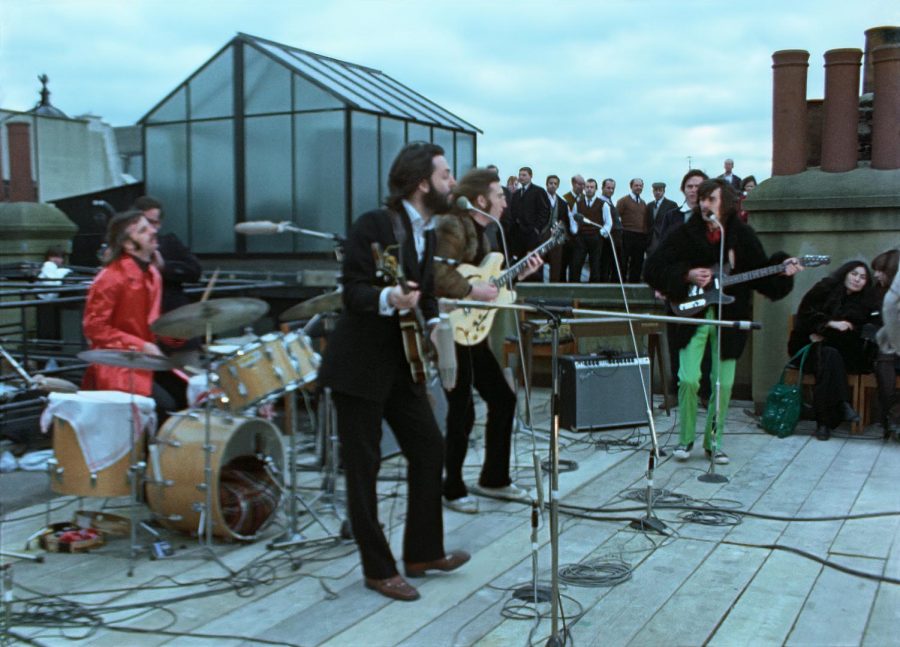A look into thein Peter Jackson’s ‘The Beatles: Get Back’
December 11, 2021
The breakup of the Beatles, which is probably one of music history’s greatest lores, has finally gotten a proper assessment thanks to Peter Jackson’s latest documentary series, “The Beatles: Get Back.” Released on Disney+ over Thanksgiving weekend, the almost eight-hour and threepart series delves into the most fractured time of the Fab Four.
Initially intended as a feature film to be released in September 2020, the COVID-19 pandemic forced it to be delayed, which made the series debute alongside a super deluxe reissue of “Let It Be.” The box set, which contains a foreword from Paul McCartney and chapters from Beatle historian Kevin Howlett has been described by music critics like David Quantick as giving “a bird’s-eye view of the sessions.”
But for the full experience of the most critical time for the band, Jackson’s docuseries takes a silver hammer and hits the nail right upon the head.
Broken up into three parts, each episode focuses on a few days, varying from five to eight, of the rehearsals for a new album and a live TV performance, which eventually turned into the infamous rooftop concert. All 42-minutes appear in episode three of the series.
In a nearly eight-hour documentary, one might think that the lulls of the moment outweigh the more explosive times, most notably when George Harrison decides to quit the band in the first episode. Yet, it is very quickly understood that when dealing with subject matters as influential and interesting as the Beatles, any lull moments are actually as informative and riveting as any others.
The most mind-boggling quiet moment comes on day four in the documentary, Jan. 7, 1969, when McCartney, in a seemingly spontaneous moment of improvisation, created the entire melody, accompanied by some mumbling lyrics, of the series titular song, “Get Back,” which appears on the band’s final album, “Let It Be.”
For Beatles fans who have had to fill in the gaps of the band’s final days from the 1970 butchered documentary film of the same rehearsals called, “Let It Be,” directed by Michael Lindsay-Hogg, this new retelling of this moment in the group’s history will serve to answer a few questions while leaving others untouched.
Firstly, did Yoko Ono break up the Beatles?
Of course not. Ono, John Lennon’s wife, has been routinely scorned by Beatles fans for her supposed part in the breakup of the quintet. While Ono is very present in the Jackson documentary, never seeming to be three steps away from her husband, she says very little and rarely interacts with the other members of the band. The long hour format of the series provides a definitive debunking of the most fabled and in some ways sexist commentary surrounding the disbandment.
Secondly, who is the fifth Beatle?
This is a title among fans that would mean a coveted honorary induction into the legendary band. The epithet has been given to various members of the group’s inner circle including their longtime manager Brian Epstein and Mal Evans, the band’s road manager who is featured heavily in
“Get Back.” But it would be hard to find anyone who after watching the series doesn’t delegate the name to keyboardist Billy Preston.
Preston, who was a well-known session keyboardist for musicians like Little Richard and Sam Cooke, met the Beatles in 1962 as a 16-year-old while touring for Little Richard. By what seems like sheer fate, Preston, who happened to be in London at the same time as the troubled “Get Back” rehearsals, appears in episode two to give the four Beatles the jolt they need to continue on with the recording of the album.
The ultimate crack-out-in-a-full-grin moment was when Preston began improvising on the electric organ alongside the band and pens the now-iconic riff that lays underneath the song, “I’ve Got a Feeling,” which appears on “Let It Be.”
“I’d just like him in our band, actually,” Lennon said the day after . “I’d like a fifth Beatle.”
While it doesn’t offer direct insight into the actual final moments of the band, “Get Back” proves that the long-reported acrimony that the four felt for each other was grossly overblown, and in fact, the band’s coda was a time rife with an explosion of creativity and genius sparked by the realization that reign of the Fab Four was coming to a necessary end.







